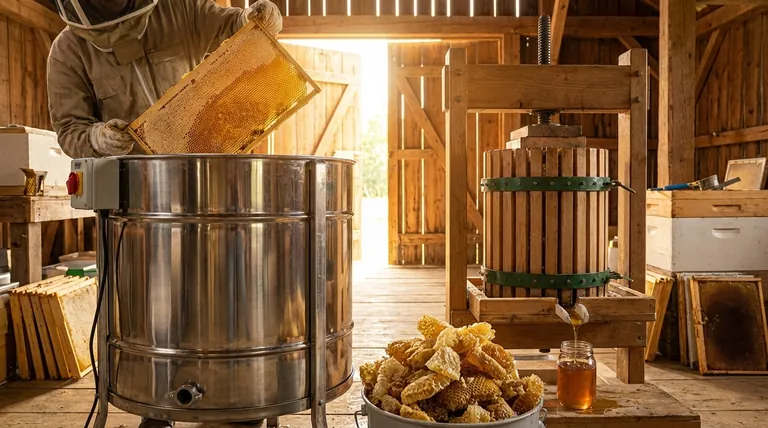Yes, the type of extractor you use has a significant impact on your honeycomb. Centrifugal extractors, whether manual or electric, are designed to preserve the delicate wax comb by spinning the honey out. In contrast, a honey press works by crushing the entire comb, which destroys it in the process of extracting the honey.
The fundamental choice is between preservation and destruction. Centrifugal extractors allow you to reuse the comb, accelerating future honey production. Honey presses yield honey and wax but require your bees to completely rebuild the comb, slowing them down.

Centrifugal Extractors: Preserving the Foundation
Centrifugal extractors are the most common tool used by beekeepers focused on honey production. They operate on a simple, effective principle.
How Centrifugal Force Works
These devices hold frames of honeycomb in a basket which is then spun at high speed. The resulting centrifugal force slings the liquid honey out of the wax cells, where it runs down the walls of the extractor drum and collects at the bottom.
The Goal: An Intact Comb
The primary advantage of this method is that, when done correctly, it leaves the wax honeycomb almost entirely intact. This empty "drawn comb" is a valuable asset.
Why Reusing Comb Matters
Bees expend a tremendous amount of energy to produce wax and construct comb. By returning an intact comb to the hive, you give the bees a massive head start. They can immediately begin cleaning the cells and refilling them with new nectar, rather than spending weeks rebuilding the wax structure from scratch.
Honey Presses: The Crush and Strain Method
A honey press operates on a completely different principle, more akin to a fruit press. This method is often called "crush and strain."
How a Press Works
Instead of spinning the frames, you cut the comb out and place it into the press. The machine then applies pressure to crush the comb, squeezing out the honey and wax together. The resulting mixture is then strained to separate the liquid honey from the solid wax pieces.
The Consequence: Total Comb Destruction
Using a honey press completely destroys the honeycomb. It cannot be salvaged or returned to the hive for reuse. This forces the bees to restart the comb-building process every single time.
Understanding the Trade-offs
Choosing a method isn't just about the equipment; it's about aligning the tool with your beekeeping goals and understanding the potential pitfalls.
The Energy Equation
The core trade-off is bee energy. Preserving comb with an extractor channels bee energy toward honey production. Destroying it with a press forces them to split their energy between building wax and making honey, which inevitably reduces your honey yield per season.
The Risk of High Speed
While extractors preserve comb, they are not foolproof. This is especially true for electric models. Starting an electric extractor at full speed can generate so much force that the weight of the honey breaks the comb's structure, causing a "blowout." Manual extractors give you a better feel for the resistance and make it easier to start slowly.
When a Press Makes Sense
A press is a viable option for beekeepers who use foundationless frames or top-bar hives, where the comb may not be structurally sound enough for a high-speed extractor. It is also suitable for those who prioritize harvesting beeswax as a primary product alongside honey.
Making the Right Choice for Your Goal
Your decision should be guided by your primary objective as a beekeeper.
- If your primary focus is maximizing honey production: A centrifugal extractor is the correct choice. Preserving your comb is the single most effective way to increase your annual yield.
- If your primary focus is harvesting wax or you use comb that can't be spun: A honey press is a functional tool, but you must accept the consequence of a lower honey yield as bees will need to rebuild.
- If you are choosing an electric extractor: Always opt for a model with variable speed control and begin your extraction slowly, gradually increasing the speed to protect the comb.
Understanding how each tool affects your bees' work empowers you to make the most strategic choice for your apiary.
Summary Table:
| Extractor Type | Impact on Honeycomb | Primary Goal |
|---|---|---|
| Centrifugal Extractor | Preserves comb for reuse | Maximize honey production |
| Honey Press | Destroys comb during extraction | Harvest wax alongside honey |
Ready to boost your apiary's efficiency and honey production?
At HONESTBEE, we supply commercial apiaries and beekeeping equipment distributors with high-quality, durable centrifugal extractors designed to protect your valuable honeycomb. By choosing the right equipment, you enable your bees to focus on honey production instead of rebuilding comb, significantly increasing your annual yield.
Contact our wholesale experts today to find the perfect extraction solution for your operation!
Visual Guide

Related Products
- HONESTBEE 72 Frame Industrial Electric Honey Extractor for Beekeeping
- Electric 8 Frame Honey Spinner Extractor Equipment for Beekeeping
- electric honey extractor honey centrifuge 3 frame honey extractor stainless steel honey frame extractor
- 2 Frame Stainless Steel Manual Honey Spinner Extractor for Beekeeping
- 40 Frame Commercial Electric Honey Extractor for Beekeeping
People Also Ask
- What are the two common types of honey extractors? Choose the Right Extractor for Your Apiary
- What should a beekeeper do after extracting honey from supers? A Guide to Harvest Management
- Can a manual extractor be upgraded to an electric one? Save Labor & Boost Efficiency
- What is the energy consumption like for automatic honey extractors? Maximize Your Harvest Efficiency
- What are the advantages of automatic honey extractors? Scale Your Apiary with Unmatched Efficiency



















